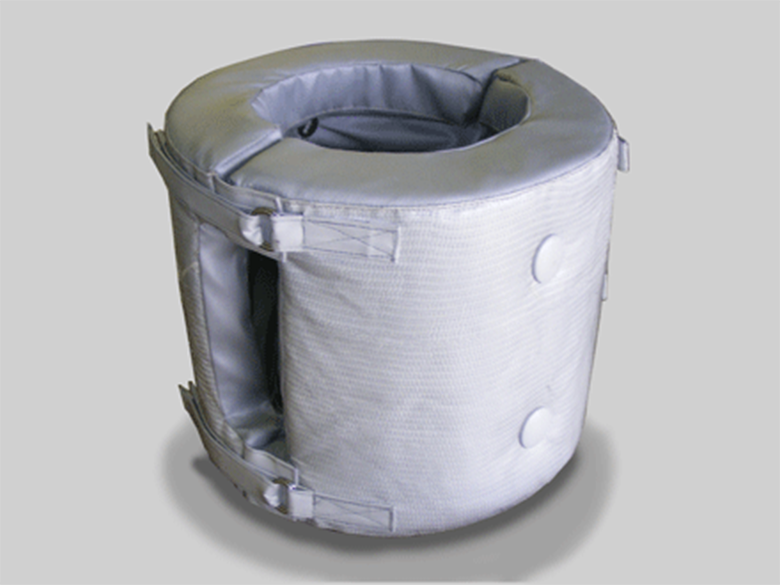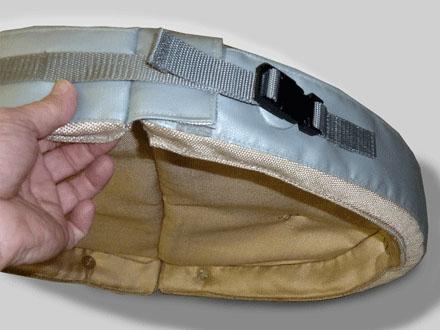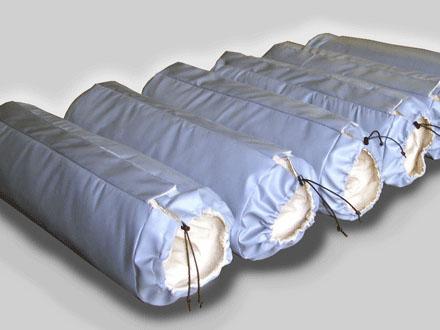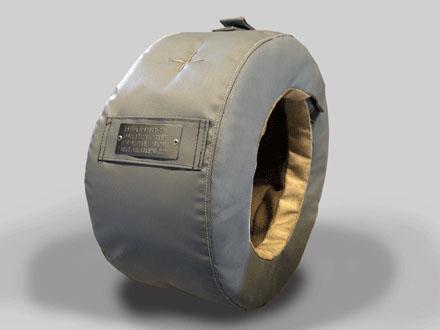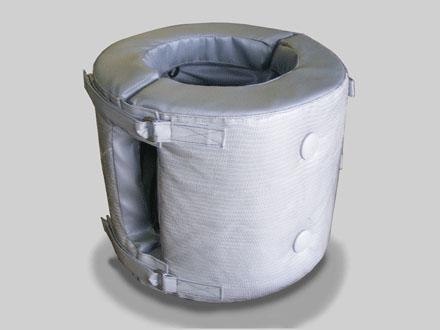ABOUT INSULATOR JACKETS AND BLANKETS
Custom Designed, Insulated Jackets offer an elegant, efficient way to apply removable insulation onto specific shapes. Insulation Jackets provide convenient access, to pipes, valves, instrumentation or any device that has to be inspected removed or visually monitored. HTS/Amptek® designs can offer increased efficiency when installed over Heating Tapes, Band or Strip Heaters. Shaped Jackets are fabricated into a preformed shape that will easily fit the object. This is opposed to flat insulation pieces which fold up and "pucker" resisting closure and leaving air-gaps.
Frequently Asked Questions
Temperature control mechanisms are recommended for all types of heating tapes. We provide temperature controls with heating tape systems to make one cohesive network, and we utilize existing controls. There are a variety of control mechanisms available and the best choice depends on the temperature, voltage, accuracy and output used in your system. A mechanical bulb and capillary thermostat are recommended for temperatures below 325 degrees F. For voltage control a variable transformer or solid-state Triac controller may be used. For precise temperature control you can activate from a bench-top or wall-mount, we recommend the BT-15 or WM-15. We supply a complete list of thermostats and similar mechanisms, and we are happy to help you select the ideal device for your needs.
Can I Leave the Unused Portion Rolled Up?
No, your heating tape will not function properly if it is not touching the heat sink from end to end. Rolled up heating tape can be hazardous, so be sure your heating tape is completely and properly installed.
How Can I Tell Which Side is "Up"?
Heating tape exhibits a uniform temperature on both sides. Either side of the heating tape may be applied to the heat sink.
Can I Cut Heat Tape?
No. Heating tapes utilize constant electric flow throughout and are designed for a fixed resistance at a given length and voltage. The tape is pre-designed to suit your environment and attempting to modify it will destroy the tape.
How Does Heat Tape Work?
Heating tapes utilize a constant watt density at a fixed resistance over a fixed length and voltage to create heat. Heat output is based on a given input voltage. Heat transference to pipes, floors and other surfaces occurs through direct contact with the tape. An insulator surrounding the enclosed heating element stops the heat from escaping and maintains a desired temperature. Temperature controls integrated into the circuit allow you to control the temperature.
Why Is Heat Tape Temperature Different in Some Places?
The materials inside the heating tape determine the operating temperature. Different heating tapes utilize different materials to create and maintain a desired temperature.
Can I Hook Heat Tape Up to a Thermostat?
Heating tapes effectively integrate with a wide variety of temperature control devices such as: thermostats, variable transformers, Triacs, solid-state digital temperature controls, programmable logic controllers (PLC's) or computers.
Why do I need different sized heat tape?
The size of your heating tape is determined by a variety of factors, including a proper mechanical fit, heat output, voltage and temperature rating, among others. Expert installers at HTS/Amptek® Company will help you select the correct heating tape size for your application to ensure optimal energy efficiency, safety and durability.
What heat tape sizes can I choose from?
HTS/Amptek® Company supplies a range of heating tape sizes to give you the best fit. Our heating tape sizes are available on our price list and online store. When choosing your heating tape, be sure to consider the heat output, voltage and temperature rating involved in your application. If you are not sure which size is best for you, contact us and we are happy to assist you.
Features AND Specifications

| Preform Shape: | Custom; Tubular, Flat, Spherical, Rectangular |
| Liner Fabrics: | F/G, Ceramic, AMOX™, Silicone, Teflon® |
| Insulation Types: | F/G Mat, Ceramic Mat, Closed Cell Foam |
| Cover Materials: | Silicone, Teflon®, Polyester Vinyl |
| Size: | Custom Modular Sizes for Convenient Install |
| Weight: | Modular, 50lbs (23kg) Max Recommended |
| Heat Capability: | Operating Temperature to 1400°F (760°C) |
| Max Exposure: | 1400°F (760°C) |
| Closures: | Velcro® Flap, D-Ring, Eyelets |
TYPICAL AND SPECIAL FEATURES
Jacket sizes:
Small Insulating Jackets may be constructed to fit ¾ inch diameter tubing and fittings. Large Heating Jackets are limited by weight, typically 50lbs (23kg), but may be constructed in multiples to fit large surfaces.
Construction:
All Jackets are pre-formed to the 3D shape and double stitched for durability. First, the inner liner is designed to suit the thermal characteristics of the application. Next, the insulation layers are placed over the liner with outer fabrics to enclose the assembly. The materials of construction depend upon the temperature and environment of use. In the freeze protection temperature range, Closed Cell Foam with Polyester Vinyl will provide insulation without absorbing moisture. For heated applications up to 500° F choices can include materials such as Teflon® and Silicone, which provide durability and some moisture protection. Moderate and High temperature Insulation Jackets, are constructed of safe fiberglass-based fabrics with soft, Fiberglass Silica or Ceramic insulations.
Temperature Capability:
Typical Construction methods can offer Fiberglass to 900°F (482°C), or AMOX™ to 1400°F (760°C). Contact HTS/Amptek® to discuss special, Ceramic based, fabrics and insulation that can offer heat ranges to 1832°F (1000°C) and higher.
Cutouts and Penetrations:
Cut outs and slits for supports, ports and other hardware are typical of most applications. HTS/Amptek® designs preformed Jacket configurations with gusseted holes, slits and seams to provide great fit and easy install and removal. Additional flaps and straps cover the exposed seams.
Closures:
Most common Closures are Velcro® flap and D ring strap or lacing eye closure methods, however quicker and cleaner methods include convenient snaps or Delrin® Clips.
Contact: HTS/Amptek®
Call or email your questions, or click the quote button for a convenient form to help us with the size and scope of your application.

